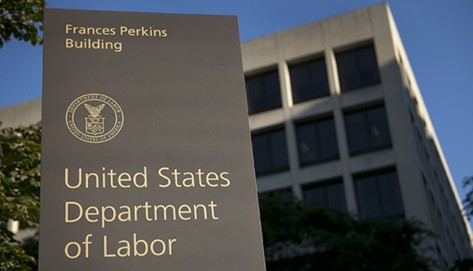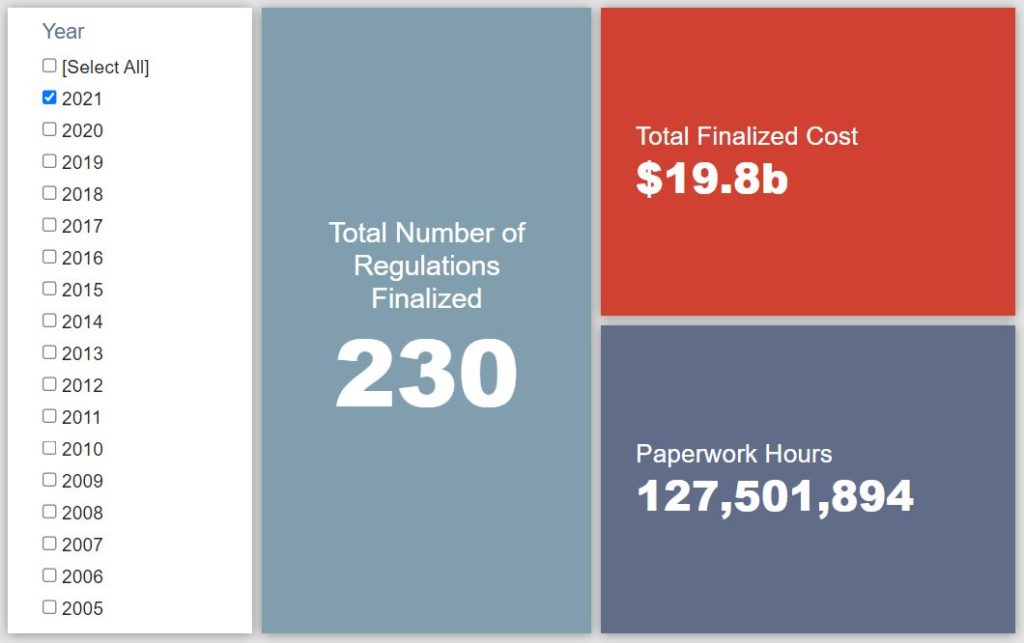Week in Regulation
November 15, 2021
A Quiet and Short November Week
After a week that swooped in with billions in potential new regulatory costs, this past week marked a lull. Across nine items with some measurable economic impact, the highest single cost estimate fell just short of $16 million. It was, however, a cross-cutting week with the various rulemakings combining for net cost increases but also net paperwork reductions. Across all rulemakings, agencies published $15 million in total net costs but cut 56,077 annual paperwork burden hours.
REGULATORY TOPLINES
- Proposed Rules: 34
- Final Rules: 52
- 2021 Total Pages: 62,791
- 2021 Final Rule Costs: $19.8 billion
- 2021 Proposed Rule Costs: $185.8 billion
NOTABLE REGULATORY ACTIONS
The most significant action in terms of costs was the Environmental Protection Agency’s (EPA) rule regarding “Response to Vacatur of Certain Provisions of the Mercury Inventory Reporting Rule.” As the title suggests, this rule is the formal recognition by EPA of a court decision vacating a previous rule. In this case it was the Second Circuit Court of Appeals striking down a 2018 rule entitled “Reporting Requirements for TSCA Mercury Inventory: Mercury.” With this vacatur, more entities will have to comply with certain reporting requirements, yielding roughly $1.5 million in annual costs (or $15.9 million total across a 10-year window). Curiously, however, the total paperwork burden associated with these mercury reporting requirements will apparently decrease by 20,522 hours. While the number of entities reporting will increase somewhat, EPA estimates that the per-entity burden will decrease in such a way that results in essentially a cumulative cut.
TRACKING THE ADMINISTRATIONS
As we have already seen from executive orders and memos, the Biden Administration will surely provide plenty of contrasts with the Trump Administration on the regulatory front. And while there is a general expectation that the new administration will seek to broadly restore Obama-esque regulatory actions, there will also be areas where it charts its own course. Since the AAF RegRodeo data extend back to 2005, it is possible to provide weekly updates on how the top-level trends of President Biden’s regulatory record track with those of his two most recent predecessors. The following table provides the cumulative totals of final rules containing some quantified economic impact from each administration through this point in their respective terms.
![]()
As noted above, it was a mixed, but relatively mild week in terms of regulatory activity for the Biden Administration. There was little change in the pole position relative to its two predecessors. The most notable development, however, came from the Trump Administration’s paperwork tally. Perhaps as a sign that its deregulatory efforts were finally taking hold in a real way, the Trump Administration saw its paperwork total dip into the net-negative range by this time in November 2017. The main driver of this development was a Department of Health and Human Services rule that cut roughly two million hours of annual paperwork, saving affected entities $146 million.
THIS WEEK’S REGULATORY PICTURE
This week, the Department of Labor (DOL) proposes to rescind a Trump-era rule regarding federal contractors.

DOL published a proposed rule in the November 9 edition of the Federal Register that would remove a Trump Administration rule finalized in 2020. The Trump-era rule modified decades of precedent by providing certain religious exemptions from civil right rules for federal contractor hiring.
In response to a handful of Supreme Court decisions that upheld protections of certain “religion-exercising organizations,” the Trump Administration’s DOL, through its Office of Federal Contract Compliance Programs, issued a rule “to correct any misperception that religious organizations are disfavored in government contracting by setting forth appropriate protections for their autonomy to hire employees who will further their religious missions.”
The rule was immediately challenged in federal court for . As that litigation was pending, the Biden Administration assumed office and asked courts to delay the case since it planned to reverse the rule.
As promised, the proposed rule would rescind the Trump Administration’s rule in its entirety. In its proposal, DOL argues that the Trump Administration misstated “the law in key respects” and undermines longstanding principles in executive orders implementing the Civil Rights Act.
The proposal is available for public comment through December 9.
TOTAL BURDENS
Since January 1, the federal government has published $205.6 billion in total net costs (with $19.8 billion in new costs from finalized rules) and 133.9 million hours of net annual paperwork burden increases (with 127.5 million hours in increases from final rules).












